Click here for Field Meeting Health & Safety Information
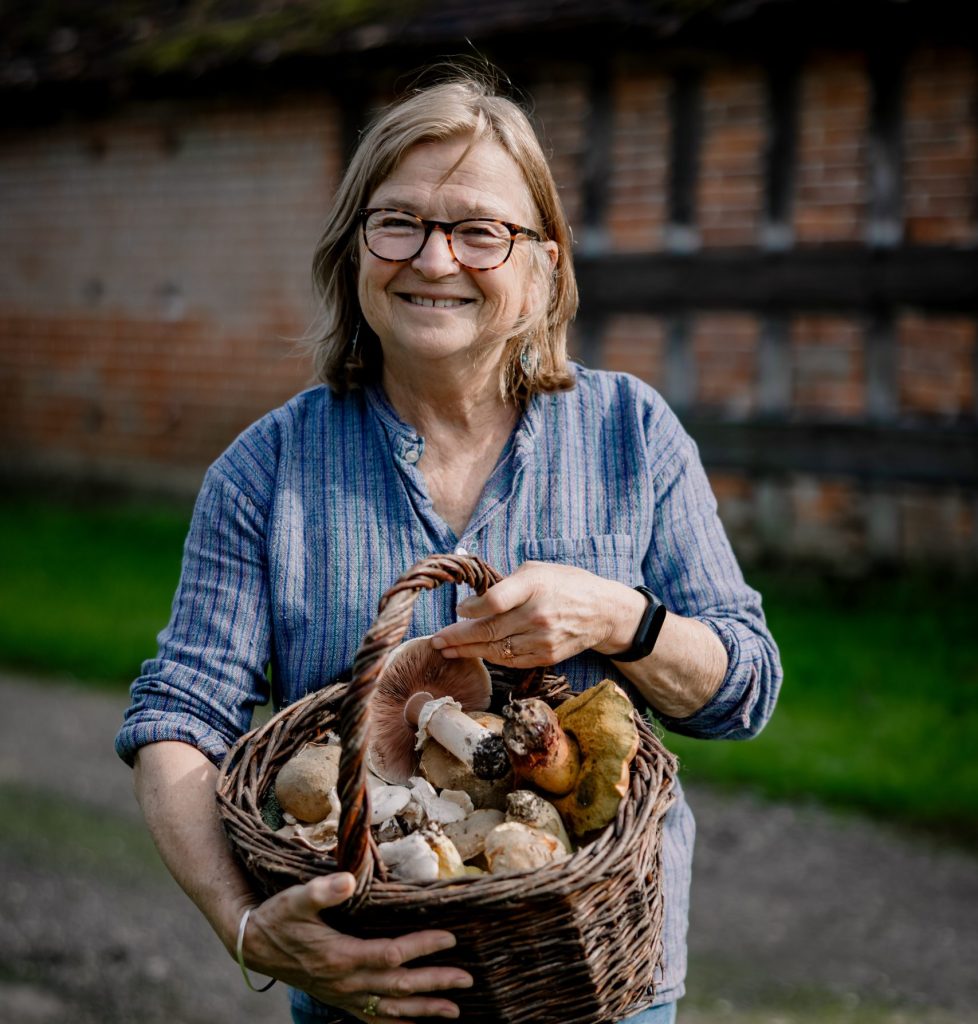
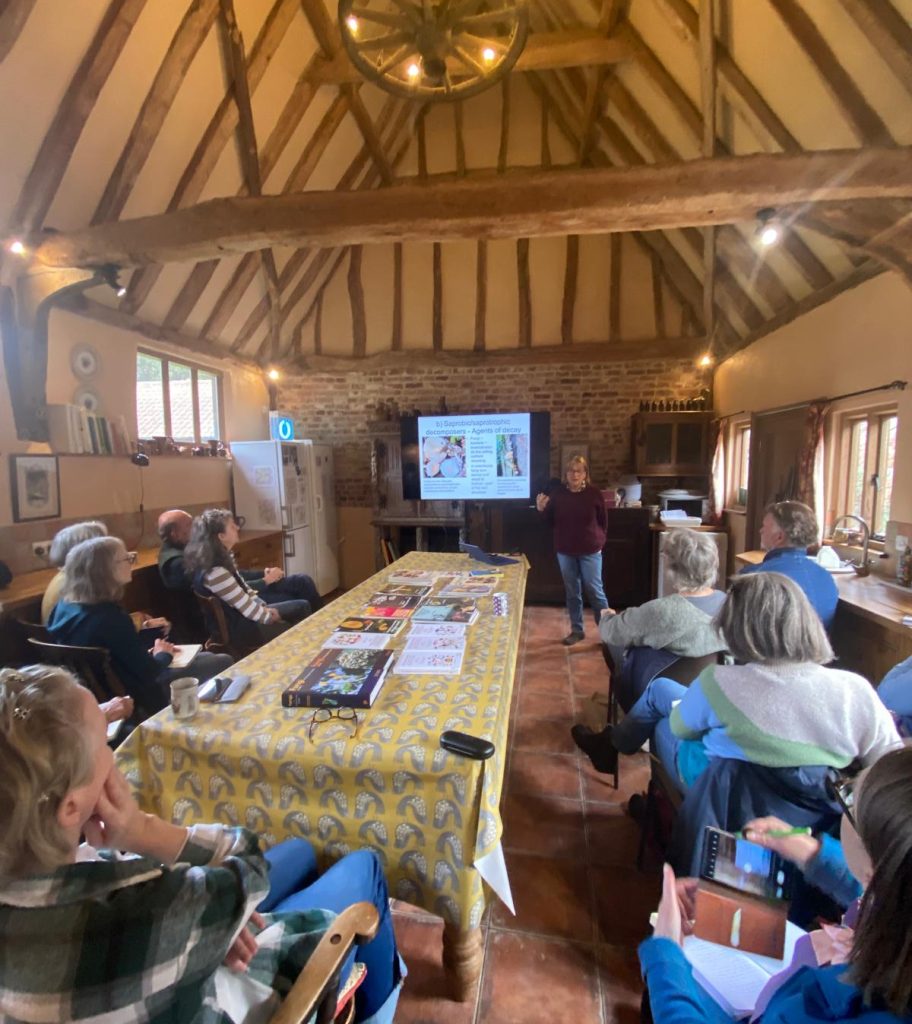
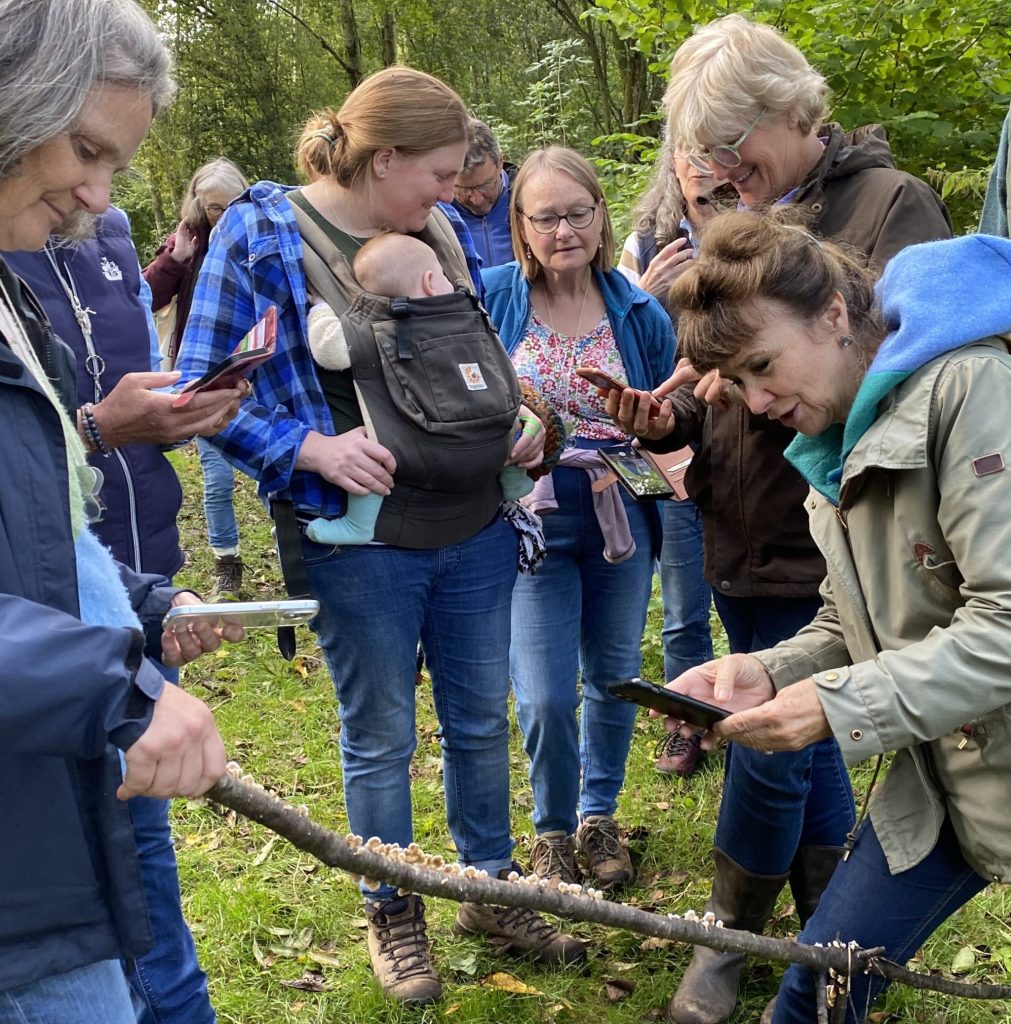
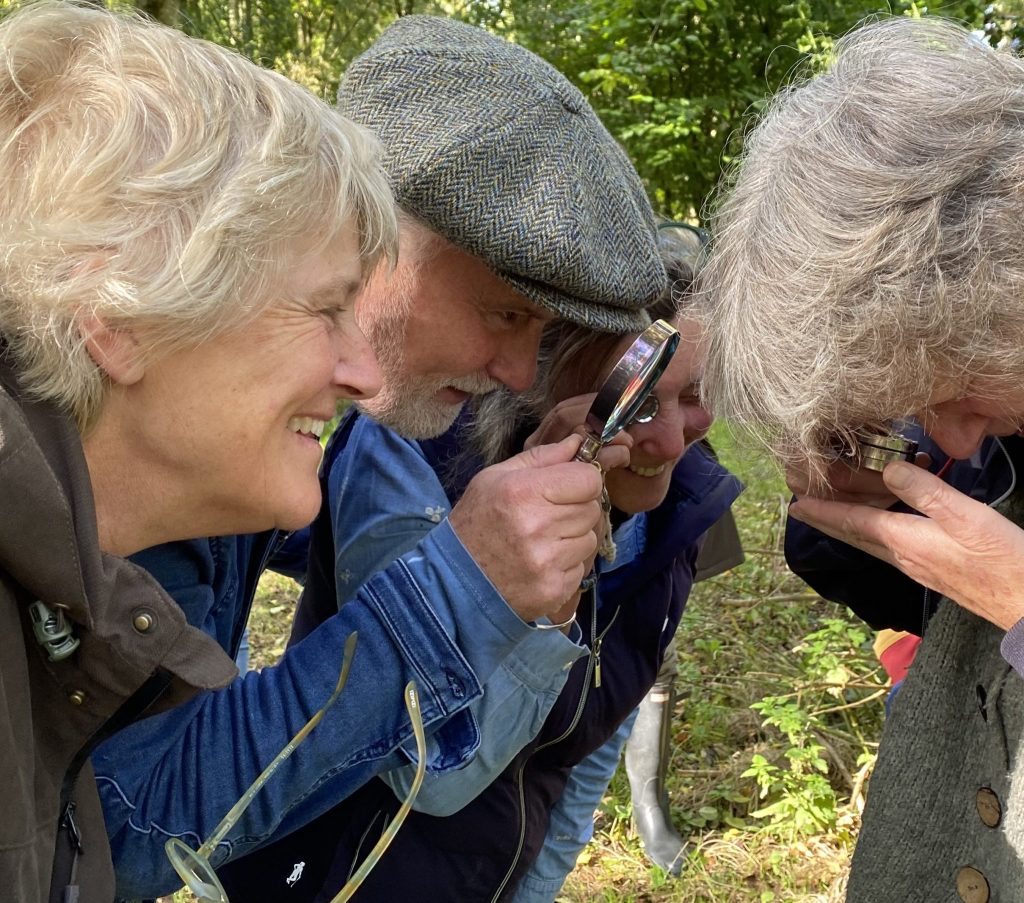
Beginners Fungi Course, Milden Hall, Sudbury
16th, 23rd October & 5th November, 9am – 4pm
In collaboration with the Suffolk Naturalists’ Society, Juliet Hawkins is running a series of three standalone day courses (introduction, woodland, and grassland fungi). Each day will start with some classroom work in the barn, followed by forays outside to practice what’s been learnt.
Juliet Hawkins, an enthusiastic amateur and fungi recorder, will provide an introduction to helping you attain or improve the following skills in the field and back at home with respect to the ‘easier’ macrofungi with gills and pores:
To know what fungi features and field clues to look for
To assess and describe a mushroom – and understand the terminology
To take the ‘right’ photos that will help identify fungi
To know where to get more help from apps/internet
To identify some macrofungi to genus, and sometimes to species, such as Milkcaps, Boletes, Funnels, Blewits, Waxcaps, Parasols, and Puffballs
To submit records online
To briefly touch on the edibility of fungi – or not!
To know when to give up on difficult species or to get further training!
Thursday 16 October: Introduction to Autumn Fungi identification – members £25, non-members £50
Thursday 23rd October: Introduction to Woodland & Grassland Fungi identification– members £25, non-members £50
Wednesday 5th November: Introduction to woodland fungi identification– members £25, non-members £50
Juliet is a keen fungi enthusiast who has pursued her passion for decades. She might not turn you into an expert overnight, but she will build your field identification skills and show you where, and when, to look for autumn fungi.
Thanks to the Suffolk Naturalists’ Society’s generous sponsorship, members can enroll on these courses at a fifty percent discount. Take advantage of this opportunity to enhance your fungi identification skills while saving money.
COURSE FEE
Suffolk Naturalists’ Society members @ £25 per day
Non-SNS members @ £50/day booked or £130 for all three days.
Note that the discount SNS receives more than pays for a year’s SNS £20 membership!
- If you can’t make all the days, don’t worry, as each day can stand alone.
- Numbers will be strictly limited to a small, manageable number.
- If you can’t make the first introductory day on 16th October, try booking on either of the two shorter introductory days that Juliet is running at Shimpling Hall Farm on 10th and 24th October – Note these are entirely independent of Suffolk Naturalists’ Society.
- If you can’t make any of the days, let us know you’re interested for another time/year, another year, and we’ll add you to our list for future dates.
To find out more or to book a place, email Juliet Hawkins at gfhawkinsltd@outlook.com
Or click here to download the full details
Previous events
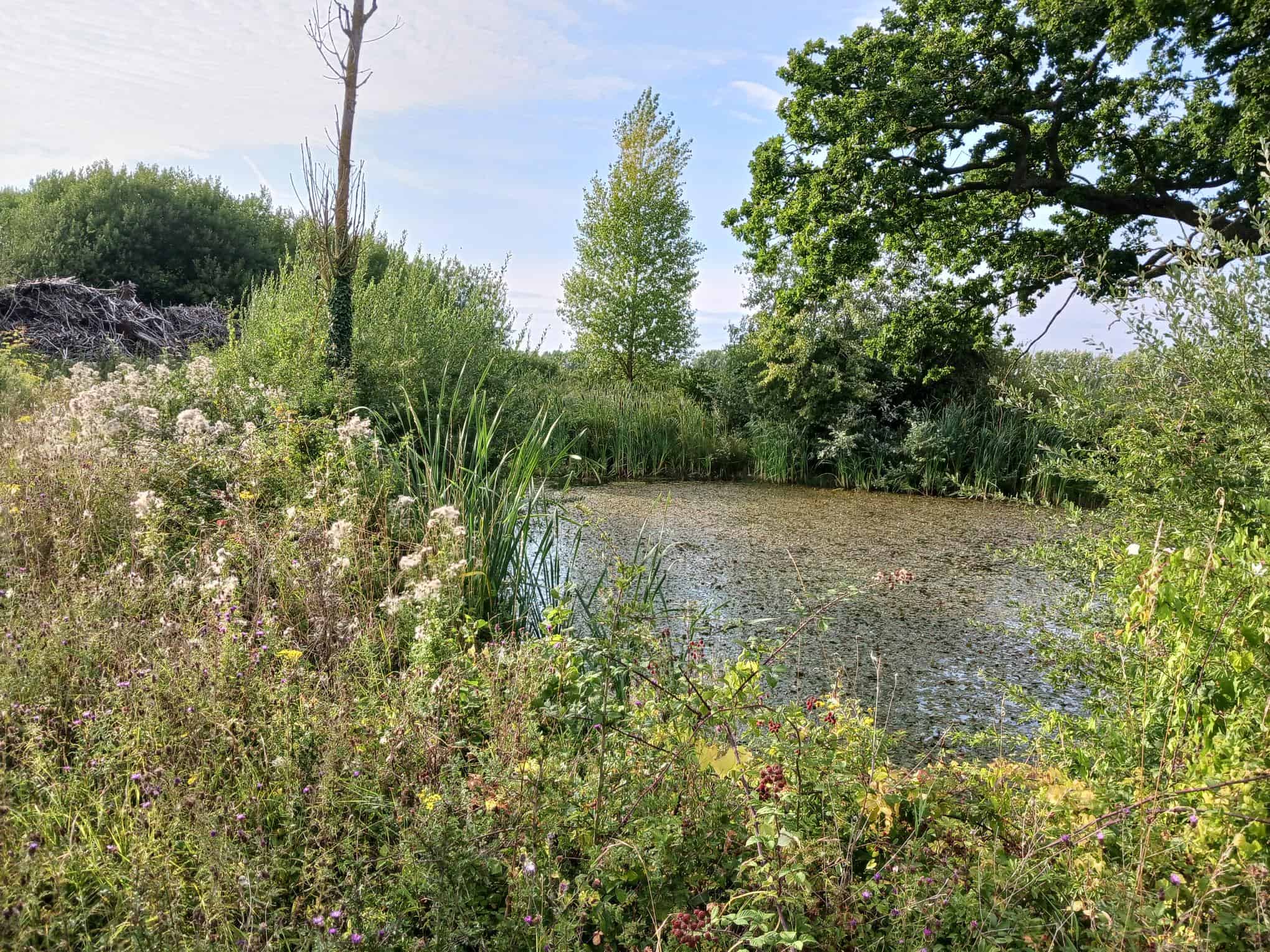
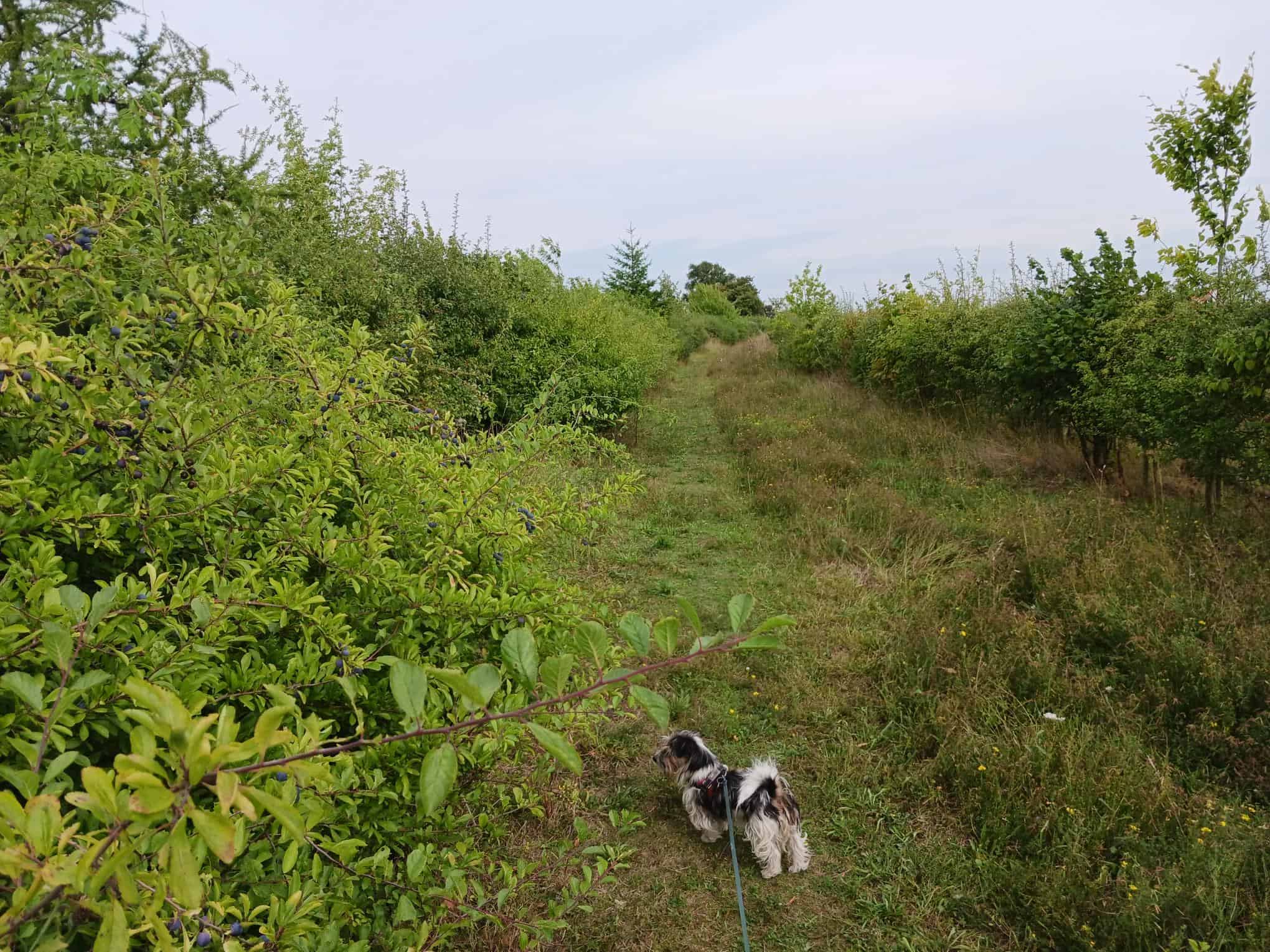
Field Meeting: College Farm, Creeting St. Mary
Saturday 23rd August 10.00am – 4.30pm
William Barnes of College Farm, Creeting St. Mary, has kindly offered to host, at short notice, a final field meeting for 2025 on Saturday, 23rd August.
William tells us:
- The farm is approximately 480 acres in size, of which around 120 acres are leased to a neighbour for farming purposes.
- We farm around 210 acres of arable land, with our fields generally having uncultivated margins. We also have varying-sized areas of woodland that have been established over the last 20 years, as well as two small mature woodlands.
- There is quite a lot of pasture, of which much is wild-flower meadow that is only grazed in the autumn.
- We have one field by the A14, which is composed of poor infill of previous sand pits (9326), featuring a mix of scrub, open land, and trees.
- There is a long margin to the north of our main watercourse, which was originally a wildflower area but has been allowed to grow naturally over many years. It is now a mix of nettle, thistle, and other plants, so it is likely to be a good area for insects, etc.
- We have planted over 5 miles of hedging and over 3,000 trees in the last two decades.
Raymond Watson will be attending and setting up his moth traps on Friday night. The contents will be available to view in the morning.
Adrian Knowles will be leading guided walks in the morning. Adrian is County Recorder for Aculeate Hymenoptera and for Hemiptera.
Other guided walks are still being confirmed.
Contact on the day: please ring Hawk on 07787 550671
Timings: 10.00am – 4.30pm
Directions: Access to the site is at grid reference TM 09896 56039
- What3words: https://w3w.co/costumes.aced.astounded ,
- Google Maps pin: https://maps.app.goo.gl/3hu22MVTcwH7vtLVA
Indoor / WC facilities: toilets are available, light refreshments will be provided, and a large barn is available if the weather turns.
Poor weather: the meeting may be cancelled at short notice.
What to bring: drinks to take on walks, a picnic and allergy medication. Bring your recording kit – SNS will have some hand lenses for guests to borrow.
Potential hazards: As with all outdoor events, please be aware that there may be stinging insects and plants, as well as uneven and/or wet ground. Please bring your allergy medication if necessary, a personal first aid kit, and a mobile phone. Hazards such as cliffs and soft ground that may be encountered will be pointed out at the start of the walks. Leaders are often volunteers and may not be equipped or qualified in first aid.
Health & safety guidance: see top of page
If you are thinking of attending, please email admin@sns.org.uk (so we have numbers for refreshments)
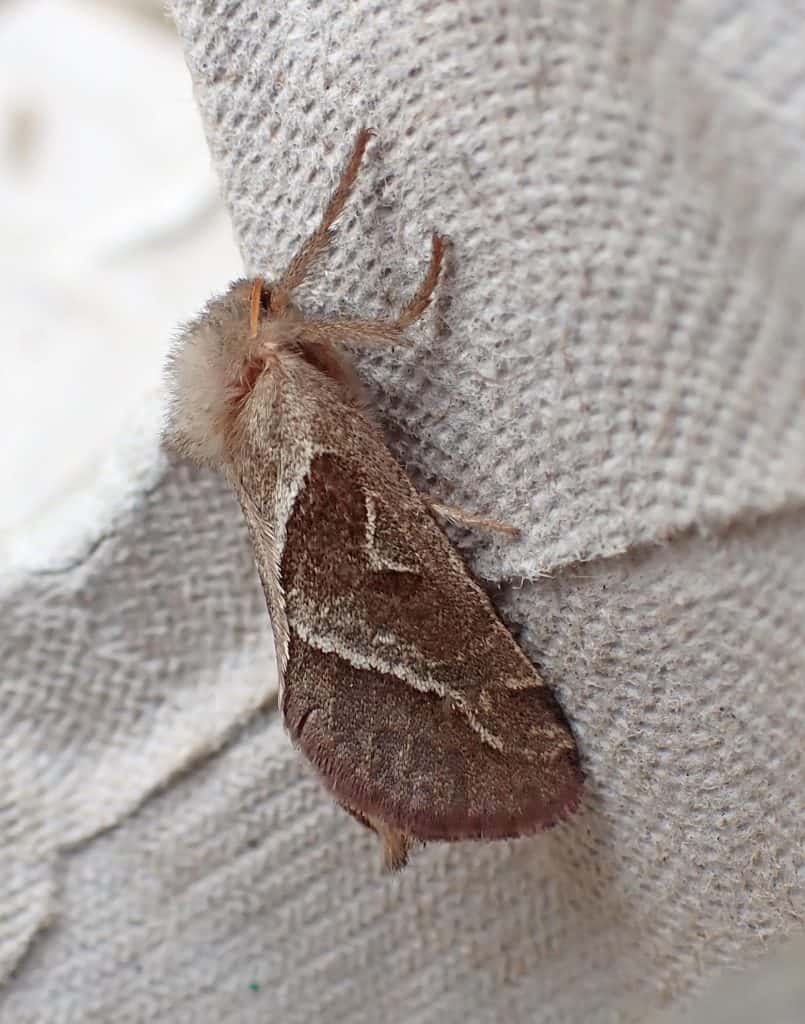
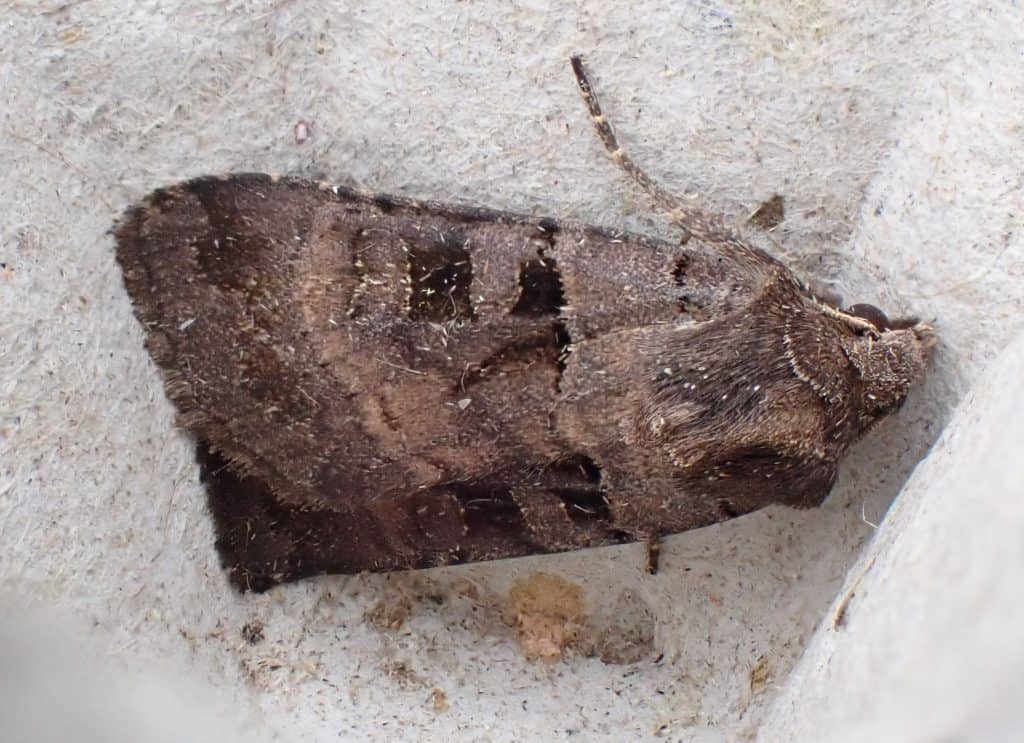
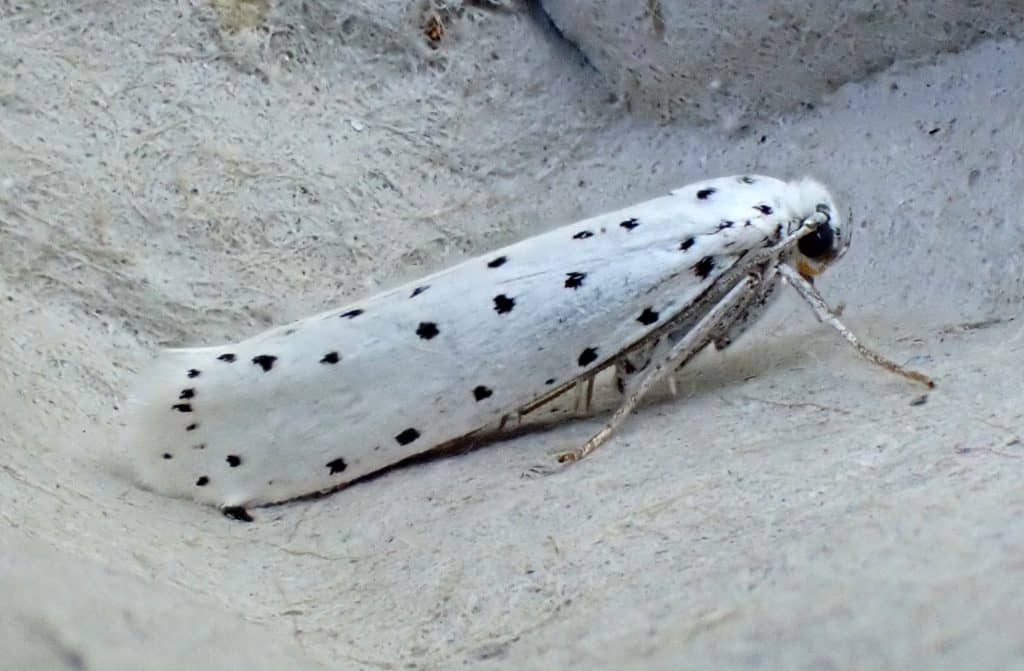
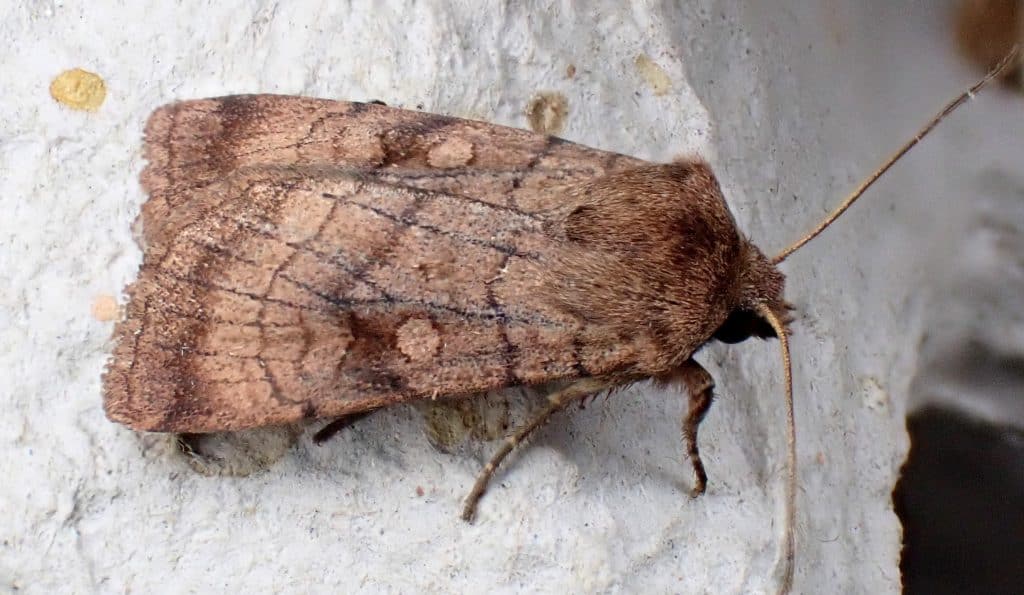
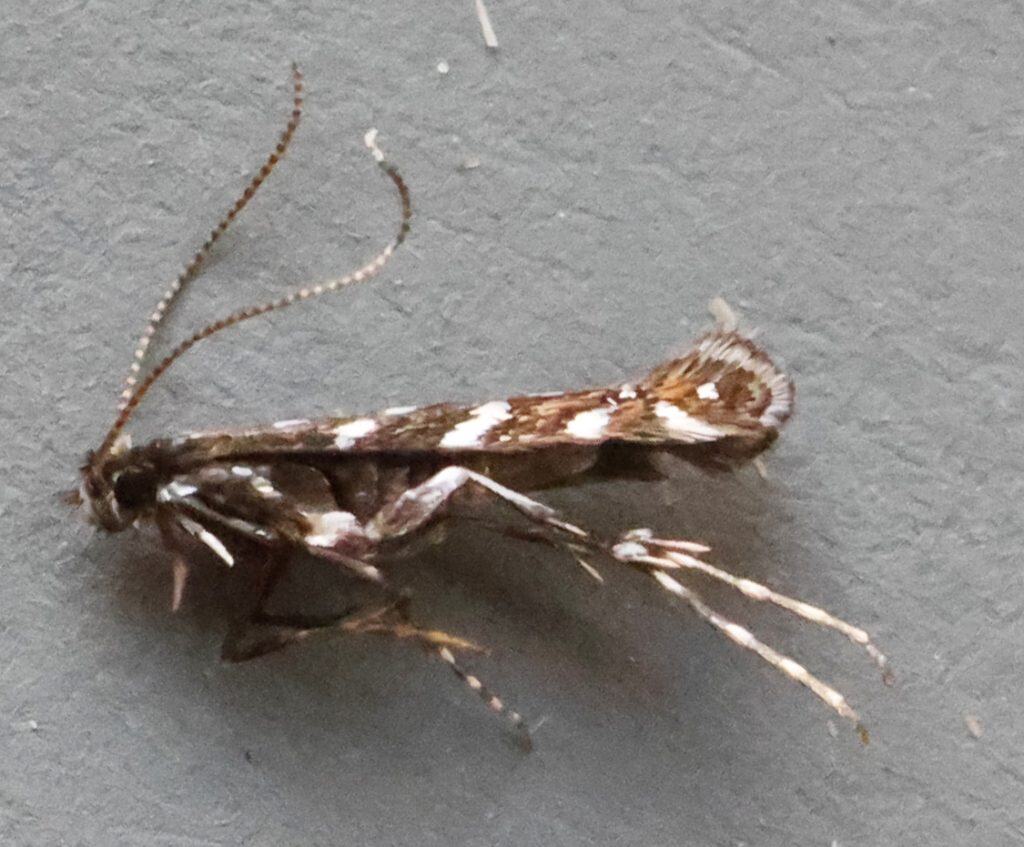
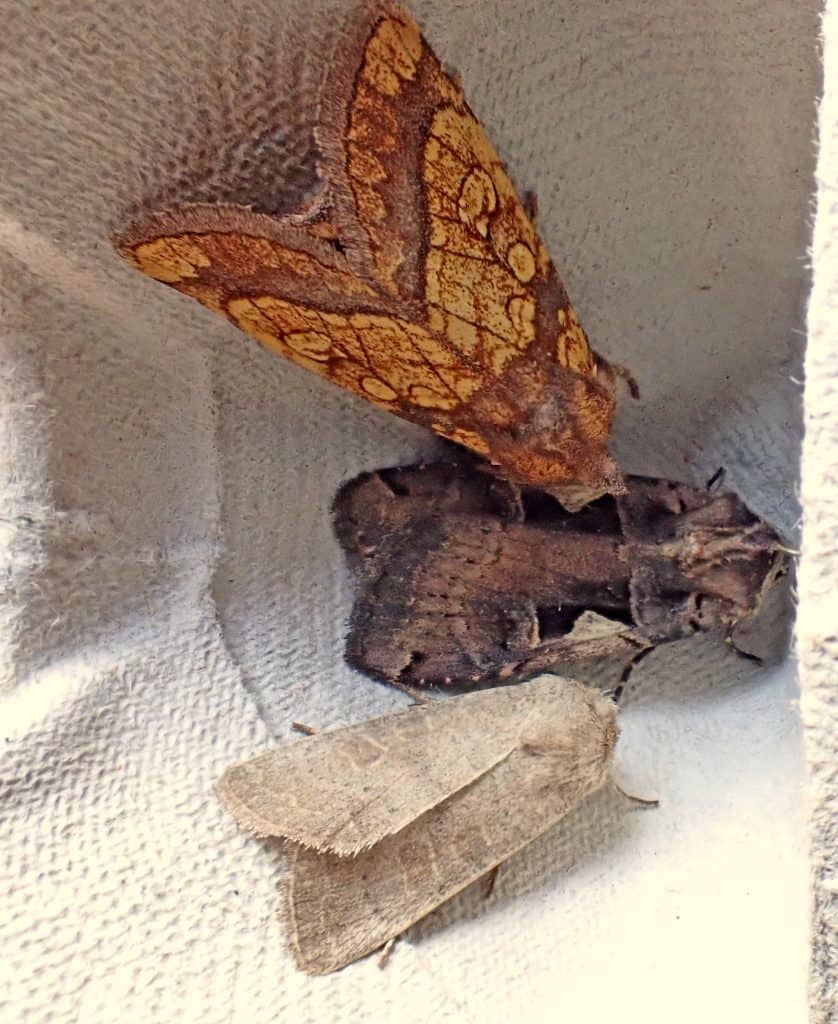
Field Meeting: College Farm, Creeting St. Mary – Report
Saturday 23rd August 10.00am – 4.30pm
The night was a good night for flying night insects. A good catch was expected. Three traps were used. Two were 125 w Mercury Vapour Robinson traps and one was a Skinner Actinic light trap. They were placed within a few hundred metres of each other. Their closeness was not an issue because of the high diversity of habitats and flora and that it was a good night for insects to fly so they would travel distances.
I have attached an Excel file with all the insects that were identified listed. A separate file for a comparison of the types of traps used is being created. I have also attached a few photos of moth species caught on the night. Two moth species were not fully identified as they flew off before a good look could be made. The Eucosma species has been listed and suggested as E. hohenwartiana because of the abundance of the foodplant and time of year but this cannot be proven. Also an Endothenia species escaped.
Some species were abundant in the traps these are shown in bold text. A few moths were exclusively immigrant species and are noted. Three species were nationally scarce: Parectopa ononidis larvae feed on clovers and rest harrow, Ypsolopha horridella larvae feed on apple and sloe and Evergestis limbata larvae feed on Hedge Mustard and Garlic Mustard whilst still classified as nationally scarce this species is currently common in Suffolk.
A few insects other than moths were captured and most have been identified. These are listed. It should be noted that the green lacewing Chrysoperla carnea is a species complex of at least three species that can only be identified without DNA from the ‘song’ of the adults.
Raymond A Watson



Exploring Westleton Common
Saturday 28th June, 11am – 6pm
Meet at Westleton Village Hall, IP17 3AD
This is a re-visit to Westleton Common following the one in September last year to look at the area at a different season and hopefully see the renowned Silver-studded Blue Butterfly.
11:00 a.m. – Upon arrival, refreshments will be available, and exhibits will be on display. There will be an introduction to the Common by Ian Webber (Westleton Common Manager) and others.
The group will make their way to the Common where there will be the opportunity to see some of its specialities such as Moths that were trapped overnight (with thanks to Raymond Watson), the Silver-studded Blue Butterfly, even perhaps the Ants that nurture them, the Antlion, other invertebrates, plant galls, Sand Martins and the geology of the area.
Specialists will be leading walks and SNS has purchased surveying equipment and identification books for borrowing, so you can try your hand at bush-whacking for Beetles, and sieving leaf litter for Pseudo-scorpions etc. These sessions will be interactive, guiding techniques and identification.
There will be a break for lunch, and the hall will be available for those who don’t want to stay in the field.
After lunch, the sessions will resume, allowing members to rotate through all the specialities.
Please take this opportunity to be introduced to wildlife in the wild rather than on a screen or in a book. Bring all your questions about identification and mobile phone apps, and we’ll do our best to answer them.
N.B. Timings and specialist sessions are subject to change at short notice.
Contact on the day: Joan Hardingham 07848 007807
Directions to the Village Hall: What Three words: defaults.obeyed.braced || TM440690 || North of Yoxford, off the A12 take signs to Dunwich. Turning left in the village the hall is on the left. The address is: Westleton Village Hall, 1842 The Street, Westleton, Saxmundham IP17 3AD
Facilities: a main hall for the talks and a side room containing natural history books/equipment stall, exhibits etc.
Parking: The car park outside the hall is limited to 6 cars plus disabled parking. There is plenty of parking on the roads either side of the Hall. Please do not park opposite the hall car park entrance.
Refreshments: There are two hostelries, The Crown and The White Horse. There is also a village shop.
Health and Safety: Please refer to the website for our policies.
Please wear appropriate clothing for the season, and be aware that the terrain can be uneven. Hazards such as cliffs and soft ground likely to be encountered will be pointed out at the start of the walks. Leaders are often volunteers and may not be equipped or qualified in first aid. There is a short walk from the village hall to the heath on a quiet village lane.
For more information, please email enquiries@sns.org.uk or fieldmeetings@sns.org.uk. If you provide your email address, we can send you updates.
More information about Westleton Common: https://westletonparishcouncil.gov.uk/westleton-common/


Lichens under the microscope
Saturday, 17 May, 10:00–15:00
Crowfield Village Hall
Free workshop sponsored by the Anglian Microscopy Group and the Suffolk Naturalists’ Society
Lichens are neglected biodiversity. Despite their ecological significance, dazzling variety and strange beauty, they’re easily overlooked. But these tiny creatures contain secrets! And microscopes can help to reveal them.
Anyone can learn how to appreciate lichens using microscopes. Seeing a lichen under a stereomicroscope for the first time is like descending to the surface of a new planet. And examining lichen sections at high magnification puts the lichen symbiosis on show: a partnership between completely different organisms that’s unique on Earth.
This one-day workshop will introduce participants to lichens and lichen microscopy. After an overview of these compelling life-forms, we’ll go outside to collect samples, which we’ll then prepare for examination. No familiarity with lichens is presumed. Experience with microscopes will be helpful, but the Anglian Microscopy Group warmly welcomes beginners!
Participants should bring hand-lenses, as well as stereomicroscopes and compound microscopes if possible. Some microscopes will be available to borrow, and other materials and equipment will be provided.
Join us for a close-up look at the fascinating world of lichens. You’ll never see them in the same way again!
- 10.00 – 11.00: Introduction to lichens
- 11.00 – 12.00: Collecting lichens (please also feel free to bring any lichens you’d like to examine)
- 12.00 – 12.45: Lunch (please bring a packed lunch)
- 12.45 – 13.00: Equipment set-up
- 13.00 – 15.00: Lichen microscopy
About the tutor
Dr Anthony Speca is a field lichenologist and educator based in northeast Suffolk. Through Aspen Ecology, he offers lichen surveying, consultancy, training and education. He’s also an active lichen recorder and lichen tutor with the British Lichen Society and the Field Studies Council, as well as a member of the Suffolk Naturalists’ Society. Anthony was first inspired by lichens when he inadvertently focused his macro-lens on a gravestone alive with them, instead of on the nearby wildflower he’d meant to photograph!
Register your interest
Places are limited, so please contact the Suffolk Naturalists’ Society at enquiries@sns.org.uk as early as possible to reserve your place.


© Frances Browne
Walk and recording event
Saturday, 10 May, 10:30 am onwards
Raydon Wood, nr Hadleigh, by kind permission of James Buckle
Raydon Wood is a 217 acre ancient woodland straddling both sides of the Hadleigh Railway Walk. It was acquired by James Buckle in 1999 when much of the wood was planted with conifers and non-native trees. Since then, this private nature reserve has been restored to a broadleaved working wood without planting a single tree, rides have been reinstated and 20 of the 30+ ponds have been restored.
Various surveys have been undertaken indicating that it is possibly the best wood in Suffolk for moths, has a large number of rare pond beetles, hosts an amazing list of ancient woodland plants, reptiles, bats and butterflies and, in spring, the joyful sound of breeding nightingales and the call of the cuckoo.
James is keen for naturalists to enjoy the wood and receive records from all taxonomic groups, so do come along, enjoy the nightingale, and record, potter, or picnic after the walk. Several county recorders will be present, so feel free to join a small recording group of your choosing.
10.15 for 10.30 am: Meet and park in Raydon Wood (directions below)
10.30 am: Intro talk from Graham Sayell, woodland manager, and Juliet Hawkins, conservation adviser since 1999
10.50 am: Walk with short talks at sites around the wood
11.45 am: Please feel free to record, potter or picnic – and find your way back to your car when you are ready.
4.00 pm: Meet up at cars for anyone who wishes to discuss findings
- Directions: The route into Raydon Wood is via a gated concrete track from Woodland Road at TM 05786 39913 or What3 Words magic.paradise.greyhound which will be signed
- Indoor/WC facilities: None!
- Poor weather: If rain stops potential recording, we will still go ahead with the talk and walk
- What to bring: Coffee flasks, a picnic, and allergy medication. Bring your own recording kit; SNS will bring some hand lenses for guests to borrow.
- Potential hazards and accessibility: As with all outdoor events, we warn you that there will be stinging insects and uneven/wet ground. However, there are also plenty of very accessible old airfield concrete tracks around the southern part of the wood. Please bring your own allergy medication, personal first aid kit (we will be separated into small groups), and mobile phone, especially if you intend to walk alone.
- Emergency services – car park area within wood: TM 05343 40264 or What3Words showrooms.dries.reviews
We hope this has piqued your interest – it really is the most glorious woodland!
We will set up a moth trap the night before the meeting – Friday, 9 May, 8 pm. Members are welcome to participate. Note that places are limited for setting up the moth traps, so please call Joan Hardingham on 07848 007807 as early as possible to reserve your spot.
96th ANNUAL GENERAL MEETING and SPRING MEMBERS’ EVENING
Wednesday 30th April 2025, from 6–10 pm
at The Athenaeum, Angel Hill, Bury St Edmunds IP33 1LU
PROGRAMME
6:00 – 6:30 pm Displays by Anglian Microscopy and natural history items for sale or offered.
6:30 – 7:00 pm ‘Introduction to Microscopy for Naturalists’ by Gordon Brown (Anglian Microscopy).
7:00 – 7:30 pm Break for refreshments.
7:30 – 8:00 pm Annual General Meeting.
8:00 – 8:30 pm Short presentations:
- Roger Horton – ‘A Story of Goldilocks’
- Martin Sanford – Orange Pore Fungus Favolaschia claudopus
8:30 – 9:00 pm Break for refreshments, the new Suffolk Flora Group will meet up during this break.
9:00 – 10:00 pm Short presentations by members (tbc) and an ‘Ask a Naturalist’ session, if time allows.
November Members’ Meeting – Report and photos
Members attended at 7:00 p.m. for a 7.30 p.m. start and were invited to bring a friend. Complimentary tea/coffee and biscuits were served, and alcoholic beverages and soft drinks were available to purchase. Over 40 people attended on a cold but dry evening, unlike last year’s wet weather. It provided an excellent opportunity for networking and catching up with old friends and colleagues. The Chair asked members if anyone would find Saturday afternoons for winter meetings inconvenient; only three raised their hands.
The talks provided a snapshot of the vast range and infinite variety that natural history studies can offer at all levels of experience. They also highlighted the importance of these studies in monitoring the state of nature and how it is adapting to human pressures and climate change. The equipment demonstrations complemented this, showing how technology can enhance this process.
Roger Horton’s talk Encounters with the Flora of Icklingham Triangle and Beyond showed the importance and botanical interest to be found in a tiny area. Worth visiting when travelling between Bury St Edmunds and Mildenhall but largely ignored by speeding traffic, is a little triangle of calcareous grassland and verges along two of its sides can reveal the enormous variation in leguminous plant species. The sandy arable field on the third side and its neighbours can be of equal botanical interest. Roger explained the site was one of several SSSIs in the area. He introduced several flowering plants worthy of note, including examples of variation in the colour of Medicago sativa subspp., nine Solanaceae species and the tiny Dianthus deltoides (Maiden Pink).
Anthony Speca’s entertaining talk was entitled First Steps on the Path to Enlichenment. A brief introduction to the curious beauty and ecological significance of lichens, including some common Suffolk species, and a warning against losing sight of this vital but neglected part of Suffolk biodiversity. He described the three groups of Lichens and their ongoing struggle against various types of pollution – (though one species was able to survive months on the outside surface of the space station!). There are 2000 taxa in the UK, of which 775 have been recorded in Suffolk, and over 40 are red-listed. Records are often over 15 years old, and it’s essential to keep these up-to-date for planning purposes. Members asked how they can be identified for recording purposes: photos are of limited value but can at least identify the specimen to one of three broad groups: crustose (flat), foliose (leafy) and fruticose (shrubby). Those associated with rocks are uncommon and, in the absence of such geological features in Suffolk, are limited to walls and graveyards. Anthony runs Lichen workshops, the details of which are on his website (aspenecology.com), and hopes to arrange some for SNS members.
Ross Piper (County Beetle Recorder) showed the dexterity needed in Card Mounting of Specimens (and other curation techniques). Most insect species in the UK can only be reliably identified by looking at them through a microscope. This means they must be prepared in some way, either by pinning or glueing to tiny cards. This is not a difficult skill to master and would allow you to study insects and contribute to what is known about the species we have in Suffolk and how they live. Ross brought beetles preserved in ethanol (the merits of various preservatives were covered), and Members could have a go themselves. The demonstration was very popular and continued into the refreshment break.
Colin Hawes gave a talk on Tapping into Primary Schools. He visited primary schools in June and July to encourage the conservation of the European Stag Beetle. Colin showed the PowerPoint presentation he gives in schools and how he engages the children and encourages the adults to put beetle logs in their school grounds. He also had his live specimens of the larvae and their earthen pupal cases, mounted male and female beetles and confusion species, including the Lesser Stag Beetle.
Neil Sherman (County Moth Recorder) gave an update with wonderful images on the state of moth recording in the county. Latest Moth news from 2024 covered interesting discoveries from the year, including new County records and the behaviour of a select few species. It was not a great year for moths owing to the wet weather. The sometimes arbitrary difference between ‘micro’ and ‘macro’ moths was explained. The Suffolk Moth Group have an excellent and constantly updated website: www.suffolkmoths.co.uk (funded by SNS) and they will be holding general meetings for non-experts to learn about moths next year.
In addition to the talks, Gordon Brown from Anglian Microscopy (www.quekett.org/about/groups/anglian) was on hand to demonstrate the use of various microscopes and promote the monthly meeting held at Crowfield near Coddenham, where people can extend their microscopy skills and The One Stop Nature Shop (www.onestopnature.co.uk) based in North Norfolk offered a range of microscopes, magnifiers, trail cameras, and thermal imaging equipment. Members could try the latest models and get expert advice on how this equipment can become a great tool for naturalists and wildlife watchers. It is hoped they found the event worthwhile and we look forward to their return.
Members and guests took advantage of the free and second-hand books and equipment on offer.
SNS would like to thank all who attended, especially those who gave their time to provide talks and demonstrations. Extracts from these talks will appear on the SNS website and Facebook page to show people what they missed! Those inspired to begin or extend their studies in any area of
natural history are encouraged to contact SNS at enquiries@sns.org.uk or the County Recorders directly.
Westleton Members’ Meeting – Photo gallery

SNS Members’ Meeting – Exploring Westleton Common
21 September 2024
Westleton Village Hall, IP17 3AD 1.30pm – 6pm
Programme – timings are approximate!
After refreshments and a look at the exhibits there will be two talks, and then we go outside for two activities. Invertebrate surveying and identification on the common and Suffolk geology at Westleton pit. The SNS gazebo will be at the common as a base to examine what has been found and for the swap over between the activities. These will be interactive sessions with guidance on techniques and identification. If you have collecting equipment please bring it along.
1.30 Doors open
Refreshments, bookstall, exhibits including: Hawk Honey, hymenoptera; Joan Hardingham, woodlice; Gavin Deans, compost critters under the microscope.
2.20 Talks
Simon Jackson (Ipswich Museum) – “the Maidenhall Mammoth” discovered in Ipswich in 1975.
John Bebbington (Westleton Parish Council) – Introduction to the history and management of the common.
2.55 Introduction to the outdoor activities.
3.15 To the common a 5-10min walk up Bakers Lane or, if driving, parking is available off the lane to the left where the SNS gazebo will be located.
3.25 Activities
Either How to survey for invertebrates and basic identification with Peter Vincent and Ross Piper.
Or Geology of East Suffolk with reference to Westleton Pit with Howard Mottram.
4.20 Return to the gazebo to swap over activities (if you wish).
5.10 Return to hall for refreshments and exhibits.
6.00 Finish
Directions: What Three Words ///snips.hatter.airbrush.
North of Yoxford, off the A12 take signs to Dunwich. Turning left in the village the hall is on the left.
Parking: The car park outside the hall is limited to 6 cars plus disabled parking. There is plenty of parking on the roads either side of the Hall. Please do not park opposite the hall car park entrance.
Contacts: For information please email enquiries@sns.org.uk, if you provide your email we can send updates.
On the day – Joan Hardingham: 07848 007807
Invertebrate Recording meeting – Sat 20 July 2024
10am – 4pm Buns and soft drinks provided
Halesworth Millennium Green invertebrate survey. Situated in the centre of Halesworth, the Millennium Green is celebrating 25 years in public ownership and to mark this occasion they are keen to update their invertebrate records for the site.
This mixed habitat comprises grassland, ponds, dykes, rivers and fens, mature trees and a smaller heathy area. SNS recorders and other specialists should find much to interest them here.
Visit the Millennium Green website
To express an interest in attending, or for further information, contact Nicky Rowbottom
Spring Members’ Evening and AGM – Wed 24 April 2024
7pm – 10pm
Venue: John Peel Centre, Church Walk, Stowmarket IP14 1ET w3w sing.sheds.spurring
There are 3 car parks with the same entrance off Gipping Way: Union Street; w3w baseballs.during.lawyer
and another at Asda, off Tavern Street B1115. Free tea/coffee and a pay bar.
7.00 pm – informal chat
7.30 pm – start of AGM business
8.00 pm – refreshment break followed by a series of short illustrated talks by members plus “Show and tell”: Please bring any items of natural history interest to share.
9.00 pm – bar closes
If you would like to give a talk please contact Martin Sanford (martin.sanford@suffolk.gov.uk). You may also like to bring specimens, books (or anything else of interest to naturalists) along for display.














































































